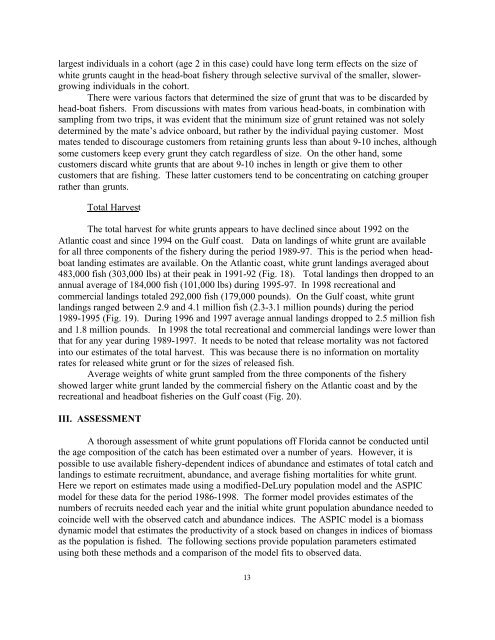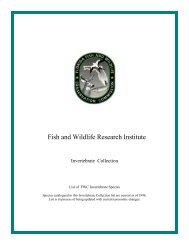STOCK ASSESSMENT OF WHITE GRUNT FROM THE WEST ...
STOCK ASSESSMENT OF WHITE GRUNT FROM THE WEST ...
STOCK ASSESSMENT OF WHITE GRUNT FROM THE WEST ...
Create successful ePaper yourself
Turn your PDF publications into a flip-book with our unique Google optimized e-Paper software.
largest individuals in a cohort (age 2 in this case) could have long term effects on the size of<br />
white grunts caught in the head-boat fishery through selective survival of the smaller, slowergrowing<br />
individuals in the cohort.<br />
There were various factors that determined the size of grunt that was to be discarded by<br />
head-boat fishers. From discussions with mates from various head-boats, in combination with<br />
sampling from two trips, it was evident that the minimum size of grunt retained was not solely<br />
determined by the mate’s advice onboard, but rather by the individual paying customer. Most<br />
mates tended to discourage customers from retaining grunts less than about 9-10 inches, although<br />
some customers keep every grunt they catch regardless of size. On the other hand, some<br />
customers discard white grunts that are about 9-10 inches in length or give them to other<br />
customers that are fishing. These latter customers tend to be concentrating on catching grouper<br />
rather than grunts.<br />
Total Harvest<br />
The total harvest for white grunts appears to have declined since about 1992 on the<br />
Atlantic coast and since 1994 on the Gulf coast. Data on landings of white grunt are available<br />
for all three components of the fishery during the period 1989-97. This is the period when headboat<br />
landing estimates are available. On the Atlantic coast, white grunt landings averaged about<br />
483,000 fish (303,000 lbs) at their peak in 1991-92 (Fig. 18). Total landings then dropped to an<br />
annual average of 184,000 fish (101,000 lbs) during 1995-97. In 1998 recreational and<br />
commercial landings totaled 292,000 fish (179,000 pounds). On the Gulf coast, white grunt<br />
landings ranged between 2.9 and 4.1 million fish (2.3-3.1 million pounds) during the period<br />
1989-1995 (Fig. 19). During 1996 and 1997 average annual landings dropped to 2.5 million fish<br />
and 1.8 million pounds. In 1998 the total recreational and commercial landings were lower than<br />
that for any year during 1989-1997. It needs to be noted that release mortality was not factored<br />
into our estimates of the total harvest. This was because there is no information on mortality<br />
rates for released white grunt or for the sizes of released fish.<br />
Average weights of white grunt sampled from the three components of the fishery<br />
showed larger white grunt landed by the commercial fishery on the Atlantic coast and by the<br />
recreational and headboat fisheries on the Gulf coast (Fig. 20).<br />
III. <strong>ASSESSMENT</strong><br />
A thorough assessment of white grunt populations off Florida cannot be conducted until<br />
the age composition of the catch has been estimated over a number of years. However, it is<br />
possible to use available fishery-dependent indices of abundance and estimates of total catch and<br />
landings to estimate recruitment, abundance, and average fishing mortalities for white grunt.<br />
Here we report on estimates made using a modified-DeLury population model and the ASPIC<br />
model for these data for the period 1986-1998. The former model provides estimates of the<br />
numbers of recruits needed each year and the initial white grunt population abundance needed to<br />
coincide well with the observed catch and abundance indices. The ASPIC model is a biomass<br />
dynamic model that estimates the productivity of a stock based on changes in indices of biomass<br />
as the population is fished. The following sections provide population parameters estimated<br />
using both these methods and a comparison of the model fits to observed data.<br />
13




